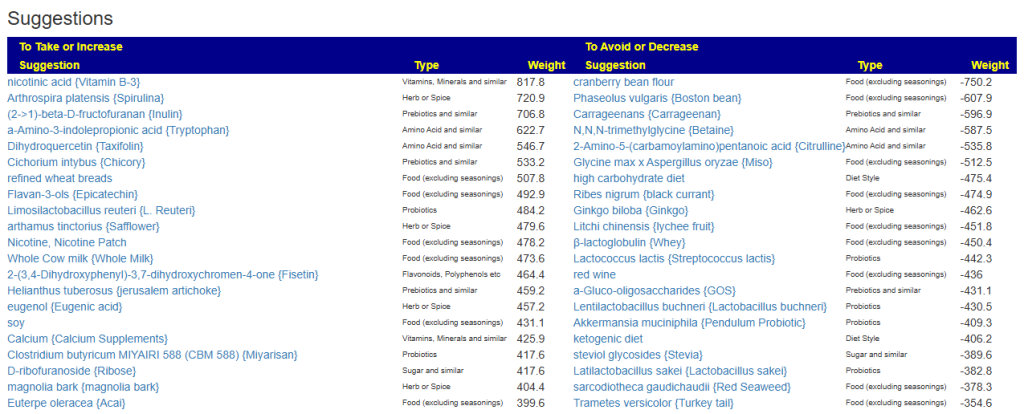Backstory
- 25 Year Old Female
- 2016: Experienced a concussion.
- 2018: Diagnosed with chronic Lyme disease.
- 2019: Dealt with chronic mold exposure
- all of the above diagnoses/symptoms improved by 2020.
- 2022: Food poisoning led to IBS-D (Irritable Bowel Syndrome with Diarrhea).
- 2024: Contracted COVID, resulting in hives, joint pain, and fatigue.
- 2024: Chronic UTIs managed with Hiprex.
- Current Symptoms:
- Persistent diarrhea and stomach cramps.
- Constant fatigue.
- Occasional joint pain.
Analysis
First Thoughts
The constant UTI infection cause a knee-jerk suggestion for the following two probiotics:
- Lactobacillus Johnsonii {Lactobacillus Johnsonii} [store] [store]
- Lactobacillus Jensenii [store] – suggestions are neutral for this
Details
The reader does not appear to have added their symptoms, but the top current symptoms is cited under Current Symptoms. In fact, there are 245 symptoms forecasts at 80% or higher…
- Lyme at 84%
- COVID at 90.1%
- Diarrhea at 90.7%
- Joint pain at 87.9

I am just going to do Novice: Just tell me what to take or avoid, to start. We have 43 bacteria identified as being too high or too low. The top suggestions are shown below

Typically I look at Probiotics first — mainly because of the common belief that they should be “cure all” In this case we have the following being usually available, I added some online stores after a few of them:
- Limosilactobacillus reuteri {L. Reuteri} [store] [store] KEGG:30/67
- Clostridium butyricum MIYAIRI 588 (CBM 588) {Miyarisan} [store] KEGG: 50 /121
- Streptococcus salivarius subsp. thermophilus {S. thermophilus} [store] KEGG: 22 /46
- Levilactobacillus brevis {L.brevis} [store] KEGG:32 /76
- Lactobacillus Johnsonii {Lactobacillus Johnsonii} [store] [store] KEGG: 22 / 47
- Enterococcus faecium {E. faecium} [store] KEGG: 29 /75
- Heyndrickxia coagulans {B. coagulans} [store] KEGG: 52 / 139
My usual suggestion is to do one at a time starting with a low dosage and then increase (double every second day) until you are at known effective dosages listed here. Keep at the maximum dosage for a week (or bottle is empty), and then proceed to the next Take notes on any changes seen (stool shape, farts, moods, etc). Some will have dramatic positive effects, others little.
The above were computed based on the complex interactions across the microbiome using literature from the US National Library of Medicine. An alternative approach for probiotic selection is using KEGG data to supplement with enzymes and metabolites that you appear to be low in.
Typical for Lyme, Long COVID and ME/CFS, Escherichia coli is the top choice (Mutaflor and Symbioflor2) at 109/293. With this method, {B. coagulans} and Clostridium butyricum would be the next choices.
Other Items
- Vitamin B-3 (explicit, not a B-Complex). B1 and B2 are to be avoided.
- Vitamin K
- {Tryptophan}
- {Taxifolin}
- {Fisetin}
- magnolia bark {magnolia bark}
- eugenol {Eugenic acid}
- {Inulin}, {Chicory},s {jerusalem artichoke}
- {Ribose} – known to help ME/CFS and Lyme often
There were no strong diet suggestions to take, but avoid high carbohydrate diet and ketogenic diet. Foods to avoid are atypical items (cranberry bean flour, cranberry bean flour, {black currant},lychee fruit etc). Also to avoid: {Ginkgo}, a-Gluco-oligosaccharides {GOS}, Carrageenans {Carrageenan}, {Stevia}.
Cross Validated for Long COVID
This is a more restricted identification of bacteria to shift. The changes found that agreed with literature is shown below.

The suggestions are shorter and includes antibiotics.

Postscript and Reminder
As a statistician with relevant degrees and professional memberships, I present data and statistical models for evaluation by medical professionals. I am not a licensed medical practitioner and must adhere to strict laws regarding the appearance of practicing medicine. My work focuses on academic models and scientific language, particularly statistics. I cannot provide direct medical advice or tell individuals what to take or avoid.My analyses aim to inform about items that statistically show better odds of improving the microbiome. All suggestions should be reviewed by a qualified medical professional before implementation. The information provided describes my logic and thinking and is not intended as personal medical advice. Always consult with your knowledgeable healthcare provider.
Implementation Strategies
- Rotate bacteria inhibitors (antibiotics, herbs, probiotics) every 1-2 weeks
- Some herbs/spices are compatible with probiotics (e.g., Wormwood with Bifidobacteria)
- Verify dosages against reliable sources or research studies, not commercial product labels. This Dosages page may help.
- There are 3 suppliers of probiotics that I prefer: Custom Probiotics , Maple Life Science™, Bulk Probiotics: see Probiotics post for why
Professional Medical Review Recommended
Individual health conditions may make some suggestions inappropriate. Mind Mood Microbes outlines some of what her consultation service considers:
A comprehensive medical assessment should consider:
- Terrain-related data
- Signs of low stomach acid, pancreatic function, bile production, etc.
- Detailed health history
- Specific symptom characteristics (e.g., type and location of bloating)
- Potential underlying conditions (e.g., H-pylori, carbohydrate digestion issues)
- Individual susceptibility to specific probiotics
- Nature of symptoms (e.g., headache type – pressure, cluster, or migraine)
- Possible histamine issues
- Colon acidity levels
- SCFA production and acidification needs
Recent Comments